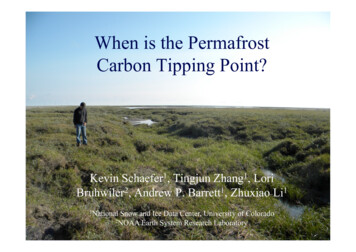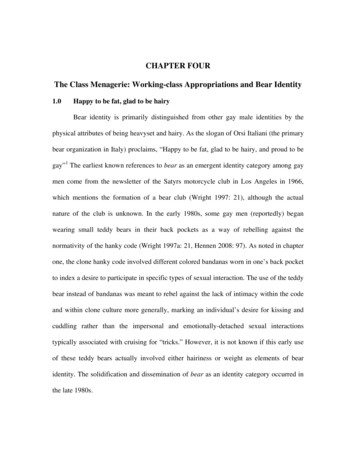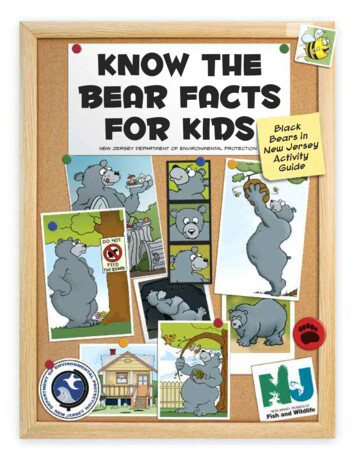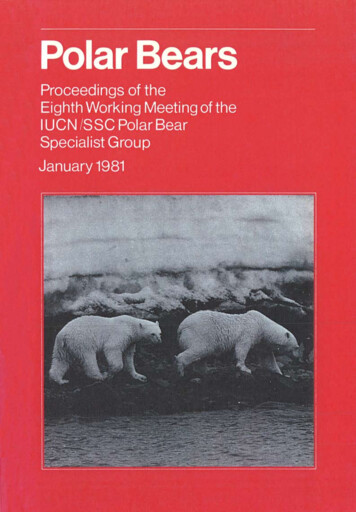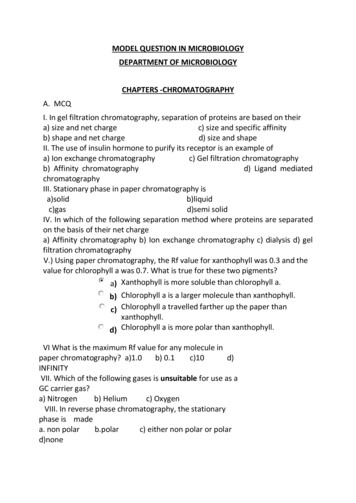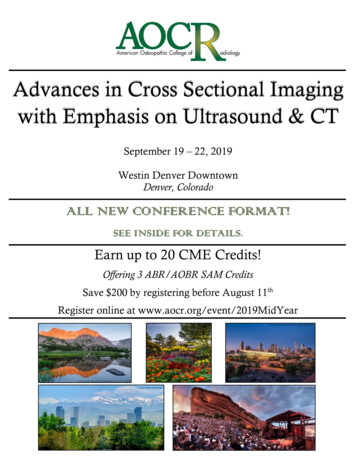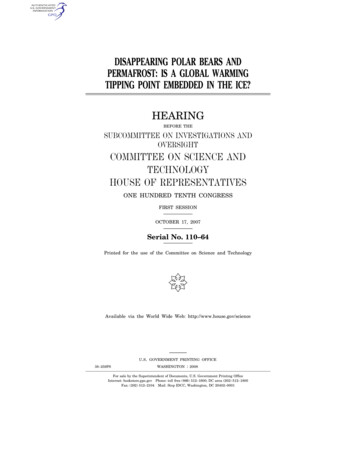
Transcription
DISAPPEARING POLAR BEARS ANDPERMAFROST: IS A GLOBAL WARMINGTIPPING POINT EMBEDDED IN THE ICE?HEARINGBEFORE THESUBCOMMITTEE ON INVESTIGATIONS ANDOVERSIGHTCOMMITTEE ON SCIENCE ANDTECHNOLOGYHOUSE OF REPRESENTATIVESONE HUNDRED TENTH CONGRESSFIRST SESSIONOCTOBER 17, 2007Serial No. 110–64Printed for the use of the Committee on Science and Technology(Available via the World Wide Web: http://www.house.gov/scienceU.S. GOVERNMENT PRINTING OFFICEWASHINGTON38–259PS:2008For sale by the Superintendent of Documents, U.S. Government Printing OfficeInternet: bookstore.gpo.gov Phone: toll free (866) 512–1800; DC area (202) 512–1800Fax: (202) 512–2104 Mail: Stop IDCC, Washington, DC 20402–0001VerDate 11-MAY-200012:38 Jul 04, 2008Jkt 038259PO 00000Frm 00001Fmt 5011Sfmt 5011C:\WORKD\I&O07\101707\38259SCIENCE1PsN: SCIENCE1
COMMITTEE ON SCIENCE AND TECHNOLOGYHON. BART GORDON, Tennessee, ChairmanJERRY F. COSTELLO, IllinoisRALPH M. HALL, TexasEDDIE BERNICE JOHNSON, TexasF. JAMES SENSENBRENNER JR.,LYNN C. WOOLSEY, CaliforniaWisconsinMARK UDALL, ColoradoLAMAR S. SMITH, TexasDAVID WU, OregonDANA ROHRABACHER, CaliforniaBRIAN BAIRD, WashingtonROSCOE G. BARTLETT, MarylandBRAD MILLER, North CarolinaVERNON J. EHLERS, MichiganDANIEL LIPINSKI, IllinoisFRANK D. LUCAS, OklahomaNICK LAMPSON, TexasJUDY BIGGERT, IllinoisGABRIELLE GIFFORDS, ArizonaW. TODD AKIN, MissouriJERRY MCNERNEY, CaliforniaJO BONNER, AlabamaLAURA RICHARDSON, CaliforniaTOM FEENEY, FloridaPAUL KANJORSKI, PennsylvaniaRANDY NEUGEBAUER, TexasDARLENE HOOLEY, OregonBOB INGLIS, South CarolinaSTEVEN R. ROTHMAN, New JerseyDAVID G. REICHERT, WashingtonJIM MATHESON, UtahMICHAEL T. MCCAUL, TexasMIKE ROSS, ArkansasMARIO DIAZ-BALART, FloridaBEN CHANDLER, KentuckyPHIL GINGREY, GeorgiaRUSS CARNAHAN, MissouriBRIAN P. BILBRAY, CaliforniaCHARLIE MELANCON, LouisianaADRIAN SMITH, NebraskaBARON P. HILL, IndianaPAUL C. BROUN, GeorgiaHARRY E. MITCHELL, ArizonaCHARLES A. WILSON, OhioSUBCOMMITTEEONINVESTIGATIONSANDOVERSIGHTHON. BRAD MILLER, North Carolina, ChairmanJERRY F. COSTELLO, IllinoisF. JAMES SENSENBRENNER JR.,EDDIE BERNICE JOHNSON, TexasWisconsinDARLENE HOOLEY, OregonDANA ROHRABACHER, CaliforniaSTEVEN R. ROTHMAN, New JerseyDAVID G. REICHERT, WashingtonBRIAN BAIRD, WashingtonPAUL C. BROUN, GeorgiaBART GORDON, TennesseeRALPH M. HALL, TexasDAN PEARSON Subcommittee Staff DirectorEDITH HOLLEMAN Subcommittee CounselJAMES PAUL Democratic Professional Staff MemberDOUG PASTERNAK Democratic Professional Staff MemberKEN JACOBSON Democratic Professional Staff MemberTOM HAMMOND Republican Professional Staff MemberSTACEY STEEP Research Assistant(II)VerDate 11-MAY-200012:38 Jul 04, 2008Jkt 038259PO 00000Frm 00002Fmt 5904Sfmt 5904C:\WORKD\I&O07\101707\38259SCIENCE1PsN: SCIENCE1
CONTENTSOctober 17, 2007PageWitness List .Hearing Charter .23Opening StatementsStatement by Representative Brad Miller, Chairman, Subcommittee on Investigations and Oversight, Committee on Science and Technology, U.S. Houseof Representatives .Written Statement .Statement by Representative F. James Sensenbrenner, Ranking MinorityMember, Subcommittee on Investigations and Oversight, Committee onScience and Technology, U.S. House of Representatives .Written Statement .Prepared Statement by Representative Jerry F. Costello, Member, Subcommittee on Investigations and Oversight, Committee on Science andTechnology, U.S. House of Representatives .79101112Witnesses:Dr. Richard B. Alley, Evan Pugh Professor of Geosciences, Department ofGeosciences, Pennsylvania State UniversityOral Statement .Written Statement .Biography .Dr. Glenn Patrick Juday, Professor of Forest Ecology, School of NaturalResources and Agricultural Sciences, University of Alaska at FairbanksOral Statement .Written Statement .Biography .Dr. Susan D. Haseltine, Associate Director for Biology, U.S. Geological Survey, U.S. Department of InteriorOral Statement .Written Statement .Biography .Ms. Kassie R. Siegel, Director, Climate, Air and Energy Program, Centerfor Biological Diversity, Joshua Tree, CaliforniaOral Statement .Written Statement .Biography .DiscussionRelation of Astrophysics to the Arctic and Polar Bears .Ms. Siegel’s Background .Are Humans Causing Climate Change? .Climate Change From the Earth’s Orbit .Evidence of Climate Change .Dr. Hansen and George Soros .Scientists Named Steve .Processes Leading to the Tipping Point .Polar Bear Population Changes in Canada .Naturally Occurring Climate Change .Reducing Methane Emissions I)VerDate 11-MAY-200012:38 Jul 04, 2008Jkt 038259PO 00000Frm 00003Fmt 5904Sfmt 5904C:\WORKD\I&O07\101707\38259SCIENCE1PsN: SCIENCE1
IVPageAction Items to Reduce Emissions .Polar Bear Populations 1,000 Years Ago .Climate Change Since the Last Ice Age .Climate Change From Carbon Methane in the Permafrost .VerDate 11-MAY-200012:38 Jul 04, 2008Jkt 038259PO 00000Frm 00004Fmt 5904Sfmt : SCIENCE1
DISAPPEARING POLAR BEARS AND PERMAFROST: IS A GLOBAL WARMING TIPPINGPOINT EMBEDDED IN THE ICE?WEDNESDAY, OCTOBER 17, 2007HOUSE OF REPRESENTATIVES,SUBCOMMITTEE ON INVESTIGATIONS AND OVERSIGHT,COMMITTEE ON SCIENCE AND TECHNOLOGY,Washington, DC.The Subcommittee met, pursuant to call, at 10:05 a.m., in Room2318 of the Rayburn House Office Building, Hon. Brad Miller[Chairman of the Subcommittee] presiding.(1)VerDate 11-MAY-200012:38 Jul 04, 2008Jkt 038259PO 00000Frm 00005Fmt 6633Sfmt 6633C:\WORKD\I&O07\101707\38259SCIENCE1PsN: SCIENCE1
2VerDate 11-MAY-200012:38 Jul 04, 2008Jkt 038259PO 00000Frm 00006Fmt 6633Sfmt 6602C:\WORKD\I&O07\101707\38259SCIENCE1PsN: SCIENCE1
3HEARING CHARTERSUBCOMMITTEE ON INVESTIGATIONS AND OVERSIGHTCOMMITTEE ON SCIENCE AND TECHNOLOGYU.S. HOUSE OF REPRESENTATIVESDisappearing Polar Bears andPermafrost: Is a Global WarmingTipping Point Embedded in the Ice?WEDNESDAY, OCTOBER 17, 200710:00 A.M.–12:00 P.M.2318 RAYBURN HOUSE OFFICE BUILDINGPurpose:On Wednesday, October 17, 2007, the Investigations and Oversight Subcommitteewill hold a hearing on the impacts of global warming on the Arctic. This hearingwill provide the Committee with an opportunity to hear from witnesses on threeinterrelated matters: (1) the current situation in the Arctic, including the situationfacing the polar bear, (2) ways in which warming in the Arctic may accelerate globalwarming, especially through the emission of more greenhouse gases, and (3) interimsteps that could be taken to reduce greenhouse gas emissions while the Congressweighs more elaborate carbon trade or tax proposals.One of the themes that should emerge from this hearing is that, from a layman’sperspective, the models used to project climate change and its ramifications appearto be conservative in their projections. This is because any phenomena that are notunderstood well enough to be represented in models with confidence are excluded.These other phenomena may accentuate or depress warming trends. In the case ofthe Arctic, most of the phenomena that have been excluded from the models are believed to accentuate warming and its effects. Few will depress it. The modeling onpolar bear survival, for example, uses projections from the IPCC models to estimatefuture changes in sea ice extent. Since the bears’ condition is very dependent uponboth the extent of the sea ice and the duration of ice-free periods, projections of thebear survival are very dependent upon projections of sea ice. This summer the seaice extent is far less than projected by the models.Some important factors that induce additional warming are either left out of IPCCmodels or are not fully accounted for, and therefore the actual decrease in sea iceextent could be significantly greater than the IPCC projections. For example, theIPCC modeling fails to include positive feedbacks from permafrost thawing whichcould add millions—even billions—of metric tons of greenhouse gases to the environment. Projections of sea level rise in the IPCC exercise do not include any run-offfrom melting ice sheets in Greenland or Antarctica because the physical dynamicsof that process are so poorly understood. The result is that, as disturbing as thepolar bear study is or as worrisome as the IPCC reports are, they probably minimizethe global warming path we are on and the consequences we will live through asa result of that warming.Recent Global Warming Reports Related to the ArcticThe past twelve months have seen two remarkable stories related to the Arctic.In January of 2007, the Department of the Interior proposed to list the Polar Bearas an endangered species. This proposal came in response to a successful lawsuitbrought by the Center for Biological Diversity, which charged that the decline in thebear’s habitat—a direct consequence of global warming—justified a listing. Subsequent information developed by the U.S. Geological Survey (USGS) provides amplereason to believe that the bear will disappear entirely from large areas of its rangein the next fifty years, and will be on the verge of extinction by 2100.Diminishing ice cover is directly tied to the survival of the polar bear. Bears relyon ice from which to hunt seals—their main prey. The analysis done by the USGSprojects that in three of the four ice eco-regions of the Arctic, it is most likely thatthe bears will be eliminated by 2100. In the fourth region, the modeling projects almost even odds that the bears will be somewhere between retaining a small popu-VerDate 11-MAY-200012:38 Jul 04, 2008Jkt 038259PO 00000Frm 00007Fmt 6633Sfmt 6621C:\WORKD\I&O07\101707\38259SCIENCE1PsN: SCIENCE1
4lation to being extinct, but it appears that even a small population may not beenough for sustaining the species beyond 2100.The disturbing quality of the USGS analysis is that their models were derivedfrom statistical projections that have not predicted as steep a decline of actual iceloss as has occurred in the Arctic. In other words, the modeling of polar bear populations assumes more ice extent than the real world is actually producing. Further,there was no accommodation to the modeling made for the consequences of otherenvironmental factors that may occur if the world begins to extract more resourcesfrom the Arctic and if a Northwest Passage becomes a reliable shipping route. Suchactivities would have a further negative effect on a remaining polar bear population.The second event that has received widespread attention has been the report thatthe melt of Arctic sea ice set a record for a new summer minimum. The NationalSnow and Ice Data Center (NSIDC) announced on October 1 that the ‘‘Arctic seaice during the 2007 melt season plummeted to the lowest levels since satellite measurements began in 1979.’’ The NSIDC lead scientist, Mark Serreze, commented that‘‘The sea ice cover is in a downward spiral and may have passed the point of noreturn. As the years go by, we are losing more and more ice in summer and growingback less and less ice in winter. We may well see an ice-free Arctic Ocean in ourlifetimes. The implications for global climate, as well as Arctic animals and people,are disturbing.’’ There has not been an ice-free summer in the Arctic in one millionyears.Diminishing bears and sea ice are only the most widely reported aspects of awarming Arctic. Global climate scientists worry about ‘‘tipping points’’—environmental processes that could lead to rapid and irreversible changes in the overallglobal climate or in sea level rise. The Arctic contains several potential sources ofa tipping point in the boreal forests, the albedo effects of melting ice and, one ofthe most worrisome, permafrost.Tipping Points in the NorthThe Arctic permafrost acts as a kind of frozen locker in which carbon is stored.These frozen soils, as well as frozen peat, extend over large areas of North Americaand Siberia—perhaps as much as 80 percent of the area. Much of the infrastructureof Russia, Alaska, and the Canadian North is built on permafrost. With thawing ofpermafrost, some of which extends more than 100 feet in depth, subsidence occurs;peoples’ homes, roads, and pipes all could be damaged or destroyed. As disturbingas these consequences are, from a global perspective there is a more profound result:thawing permafrost release stored carbon as either carbon dioxide or as methane.Estimates of the total stored carbon in Arctic soils are in the range of one thousand gigatons. (See Zimov, Schuur, Chapin III, ‘‘Permafrost and the Global CarbonBudget,’’ Science Magazine, Vol. 312, 16 June, 2006). No one knows how much iscurrently being released, though there are anecdotal reports of methane emergingso quickly from pools in Siberia that it keeps ice from freezing in the dead of winter.The Stordalen mire in Sweden has been observed to produce a 22–66 percent increase in methane emission as the permafrost thawed. (Christensen, et. al., ‘‘Thawing sub-arctic permafrost: Effects on vegetation and methane emissions,’’ Geophysical Research Letters, V. 31, L04501, 2004).Work done at the National Center for Atmospheric Research (NCAR) projects thatover half of the topmost layer of permafrost (top ten feet) will have thawed by 2050and as much as ninety percent could thaw by 2100. The analysts worked on thisquestion with an eye to modeling increased water runoff from the permafrost intothe Arctic Ocean. Their model did not tackle the question of carbon emissions fromthawing permafrost, but they conceded that such releases ‘‘may be considerable andthe feedback is likely to be positive and possibly large.’’ (Lawrence & Slater, ‘‘A Projection of Severe Near-Surface Permafrost Degradation During the 21st Century,’’Geophysical Research Letters, V. 32, L24401, 2005).While scientists know that thawing permafrost and the release of carbon storedin its frozen matrix could have an enormous impact on overall greenhouse gas emissions, none of the modeling done for the IPCC takes this feedback mechanism intoconsideration. Past and present anthropogenic emissions of greenhouse gases mayso warm the planet that aggressive efforts over the next thirty years to reduce anthropogenic emissions may not be enough to stop the thawing of permafrost and therelease of the enormous stores of carbon in those soils.Permafrost is not the only potential source of accelerated warming. Another potential source for carbon releases lies in the boreal forests of the North. The regionis warming and large areas of North America’s Arctic have been subjected todrought. The warmer weather has made the region more hospitable to insects thathave attacked the massive conifer boreal forests. In the Province of British Columbia, Canada, pine beetles have become an ‘‘epidemic.’’ As of 2006, the beetles hadVerDate 11-MAY-200012:38 Jul 04, 2008Jkt 038259PO 00000Frm 00008Fmt 6633Sfmt 6621C:\WORKD\I&O07\101707\38259SCIENCE1PsN: SCIENCE1
5destroyed 6 billion worth of trees and the provincial government began pushing amassive logging increase to try to get ahead of the insect-driven losses. It is estimated that B.C. alone contains almost seven percent of the world’s softwood. As aresearcher at the Pacific Forestry Centre in Victoria, Allan Carroll, puts it, ‘‘There’sno question [the pine beetles] range has expanded over the last 30 years due toameliorating climate. . .’’ (Webster & Cathro, ‘‘Bitter Harvest: Pine Beetle Infestation in B.C.,’’ Canadian Business, January 2006).Insect-weakened, dry trees are subject to fire. This past summer saw the largestforest fire ever witnessed on Alaska’s North slope. On July 16, 2007 lightning started a fire that was still burning in the first week of October. It had consumed morethan a quarter of a million acres of forest during its run, and the smoke plume couldbe seen from 50 miles away. Scientists in Alaska are concerned that the fire mayhave damaged the permafrost beneath the forest, causing deeper thaw. As thesetrees burn, and others succumb to drought and insects, carbon is released into theatmosphere. The loss of trees to store carbon and the release of carbon from dyingforests is a potentially important source of greenhouse gases. (Hopkin, ‘‘AlaskanFire Damages Permafrost,’’ Nature, published online 9 October 2007).Finally, the change in albedo in the North could have an important impact onoverall global temperature. As snow and ice melt, they reveal the darker Earth andocean. The overall color of the planet’s surface directly affects how much solar energy is absorbed by the planet and how much is reflected back out into space. Beingdarker, the sea will absorb more solar energy, warming the seas and acceleratingthe melting of the ice. A similar process happens on land that would traditionallybe covered by snow. (Note that the loss of boreal forests may have a small negativefeedback by revealing a lighter ground under the dark trees—thus reflecting marginally more solar energy back into space than the forests).Any of these processes that either cause the Earth to absorb or retain more solarradiation will add to the overall warming of our atmosphere. If the atmospherewarms enough to reach a tipping point on the ice sheets of Greenland or Antarctica,the consequences for coastal communities and the world economy would be devastating. Scientists do not fully understand the dynamics of ice sheet melting, butit is not a simple linear process where a certain temperature produces a certain rateof melt. Rather there are feedbacks in the melting of the sheets that suggests anexponential or accelerating reaction occurs when melting begins. If the ice sheetsof Greenland and Antarctica were to both melt, it would increase the sea level byapproximately 200 feet. Experts believe that such an event is extremely unlikely.As one of our witnesses will testify, it is expected that increases in sea level willnot occur so rapidly as to raise sea level at the rate of meters over coming decades.However, because the physical dynamics of ice sheet melting are not well understood, they were simply left out of the IPCC’s most recent projections of sea levelrise in the 21st Century. We currently have no reliable, comprehensive projectionof sea level rise due to this gap in our understanding of ice sheet dynamics in conditions of warming.A Modest Proposal for ActionThe Center for Biological Diversity will appear to provide some advice on stepsthat can be taken to reduce warming, with particular emphasis on their efficacy inthe Arctic. Among the steps they advocate are programs to reduce methane emissions and ‘‘black carbon.’’ Black carbon is soot that, in the Arctic, has a particularlypernicious effect. When it is deposited on snow and ice it decreases its reflectivityand increases its heat absorption leading to greater melting. As the Arctic comesunder more and more industrialization with other warming, one could anticipatefurther production of black carbon. Methane is a powerful greenhouse gas, with anestimated global warming potential 23 times greater than carbon dioxide over a 100year time frame. Methane is a precursor to tropospheric ozone. In that form, it trapsshortwave radiation as it enters the Earth’s atmosphere from the sun and thenwhen it is reflected back again by snow and ice. As a consequence, its impact isstrongest over the Poles. Reducing global methane emissions would provide a particular benefit to the Arctic.WitnessesDr. Sue Haseltine is the Associate Director for Biology at the U.S. Geological Survey, U.S. Department of Interior and will make a presentation of their findings regarding the future of the polar bear.Ms. Kassie R. Siegel is the Director of the Climate, Air and Energy Program atthe Center for Biological Diversity. She will present their preliminary plan for themitigation of methane emissions.VerDate 11-MAY-200012:38 Jul 04, 2008Jkt 038259PO 00000Frm 00009Fmt 6633Sfmt 6621C:\WORKD\I&O07\101707\38259SCIENCE1PsN: SCIENCE1
6Dr. Richard Alley, Evan Pugh Professor of Geosciences at Pennsylvania State University, appeared before the Committee to testify about the findings of the IPCC report earlier this year. He will testify about matters including sea ice, albedo andice sheet melting. He can also answer questions regarding what factors have andhave not been included in IPCC modeling on the climate.Dr. Glenn Juday is a Professor at the School of Natural Resources and Agricultural Sciences, University of Alaska at Fairbanks, one of the worlds leading centersfor the study of the Arctic. He will testify regarding both permafrost—what we doand do not understand about its potential release of carbon—and the boreal forests.VerDate 11-MAY-200012:38 Jul 04, 2008Jkt 038259PO 00000Frm 00010Fmt 6633Sfmt 6621C:\WORKD\I&O07\101707\38259SCIENCE1PsN: SCIENCE1
7Chairman MILLER. Good morning. The hearing will come toorder. Today’s hearing is entitled Disappearing Polar Bears andPermafrost: Is a Global Warming Tipping Point Embedded in theIce?This committee held three hearings on the 2007 report of theIntergovernmental Panel on Climate Change, IPCC, one of lastweek’s winners of the Nobel Prize for Peace. The report of theworking group on impact, adaptation, and vulnerability stated thatthe rapid climate changes occurring in the Earth’s polar regionswould have cascading effects on key regional bio-physical systemsand cause global climatic feedbacks.The report described the polar regions as geopolitically and economically important and extremely vulnerable to current and projected climate change. And the report said the polar regions hadthe greatest potential to affect global climate change and thushuman populations and biodiversity.In the past twelve months, there have been two remarkable stories related to the Arctic that suggest that those climate changesmay be happening even faster than predicted and with significantnegative consequences. Earlier this month, the National Snow andIce Data Center at the University of Colorado reported that theArctic sea ice cover in the summer of 2007 had fallen to its lowestpoint since 1979. Sea ice coverage was 39 percent below the longterm average for 1979 to 2000 and perhaps half the sea ice coverage of the 1950s.According to the Center, Arctic sea ice has long been recognizedas a sensitive climate indicator. When global temperatures rise, thesea ice cover sinks, and global temperatures in the Arctic haverisen four degrees Fahrenheit since 1950. The lead scientist for theSnow and Ice Center warned that the sea ice cover is in a downward spiral and may have passed the point of no return. As thesummers go by, we are losing more and more ice in the summerand growing less and less back in the winter. We may well see anice-free Arctic Ocean in our lifetimes. The implications for globalclimate, as well as Arctic animals and people, are disturbing.There has not been an ice-free summer in the Arctic in a millionyears.Not surprisingly, the U.S. Geological Survey in September issueda report projecting that, based on the projected sea ice melts, twothirds of the world’s polar bears will be gone by 2050. The USGSstudy projects that in three of the four ice eco-regions of the Arctic,it is most likely that the bears will be extinct by 2010. In thefourth region, the modeling projects almost even odds that thebears will be somewhere between having a small population tobeing extinct, but a small population may not be enough to sustainthe species.Polar bears are adapted to hunting from sea ice. They hunt primarily ringed seals and to a lesser degree bearded seals. Less seaice means less habitat. The USGS analysis relied on models toproject polar bear populations that are more conservative about themelting of sea ice than the steeper decline that is now being observed in the Arctic. Polar bears are adapted to hunting from seaice.VerDate 11-MAY-200012:38 Jul 04, 2008Jkt 038259PO 00000Frm 00011Fmt 6633Sfmt 6601C:\WORKD\I&O07\101707\38259SCIENCE1PsN: SCIENCE1
8Diminishing bears and sea ice are only the most widely reportedaspects of a warming Arctic. Global climate scientists worry abouttipping points, atmospheric processes that could lead to a rapid andirreversible change in the overall global climate or in sea level rise.The Arctic contains several potential sources of a tipping point inthe boreal forests, the albedo effect of melting ice and one of themost frightening, carbon and methane release from melting permafrost.Again, the polar regions, the Arctic and the Antarctic, have thegreatest potential of any region to affect global climate everywhere.The impacts of global warming will be greater in the polar regions,and those impacts will also produce feedback effects that have globally significant consequences. First, ice and snow reflect solar radiation in a process known as albedo. It helps keep the Arctic cooland the Earth cooler. When there is less ice and less snow, the exposed soil and water absorb solar radiation instead of reflecting it;and more solar radiation and warmth reaches land and stays in theatmosphere. It becomes a cycle. Ice melts and snow cover is reduced, resulting in less reflectivity and more warming, resulting inmore ice melting and reduction of snow cover and on and on.Second, because of higher temperatures in the Arctic, the permafrost beneath large sections of Europe, Russia, Alaska and Canadais also beginning to melt. There are estimated to be almost 1,000gigatons of carbon trapped in Arctic permafrost. A gigaton is a billion tons. Human use of fossil fuels currently emits approximatelyseven gigatons of carbon annually. In 2005, scientists at the Snowand Ice project projected 50 percent decrease of the topmost layerof permafrost by 2050 and as much as a 90 percent decrease by2100. If that happens, the resulting release of CO2, carbon dioxide,and methane could have a warming effect on our climate that defies imagination.Another potential source for carbon release rests in the borealforests of the North. Warmer weather has made them vulnerableto insect pests, and drought has resulted in the largest forest fireever witnessed on Alaska’s Northern Slope. It may also have damaged the permafrost.None of the models used in the IPCC projections of the impactof global warming took into account the potential release of thosegigatons of carbon. A vast area of the world that has been a netcarbon sink could become a carbon dioxide and methane producerthat would dwarf the production of carbon dioxide and methanenow resulting from human activities. As Dr. Ted Schuur wrote inScience magazine, factors inducing high-latitude climate warmingshould be mitigated to minimize the risk of a potentially large carbon release that would further increase global warming.Rapid Arctic ice and permafrost melt are the kind of events withcascading effects that tip the planet’s climate into an uncontrollable cycle of warming. The result could be an acceleration of themelting of the ice sheets in Greenland, inundating coastal communities and devastating the world economy.For 20 years we have heard warnings from scientists, first in ahearing here held by Mr. Gore, an alumnus of this committee.VerDate 11-MAY-200012:38 Jul 04, 2008Jkt 038259PO 00000Frm 00012Fmt 6633Sfmt 6601C:\WORKD\I&O07\101707\38259SCIENCE1PsN: SCIENCE1
9Now we are seeing the consequences of global warming in the endangering of polar bears, in
warming Arctic. Global climate scientists worry about ''tipping points''—environ-mental processes that could lead to rapid and irreversible changes in the overall global climate or in sea level rise. The Arctic contains several potential sources of a tipping point in the boreal forests, the albedo effects of melting ice and, one of

